
Schloss Kirchheimbolanden is located in the town of Kirchheimbolanden in the German state of Rhineland-Palatinate. As a castle the site was first mentioned in a document as early as 1390.

Schloss Kirchheimbolanden is located in the town of Kirchheimbolanden in the German state of Rhineland-Palatinate. As a castle the site was first mentioned in a document as early as 1390.
From 1602 to 1618, a castle (the so-called "old castle" or Alte Schloss) was built outside the actual town walls by the counts of Nassau-Weilburg, who had their permanent residence at Schloss Weilburg in Weilburg on the Lahn.
A new building was erected between 1738 and 1740 under Prince Charles Augustus of Nassau-Weilburg. Charles Augustus was an imperial prince and wanted a modern building. Guillaume d'Hauberat was engaged as architect and master builder; he also built Mannheim and Schwetzingen Palaces for the Elector of the Palatinate. A schlossgarten was to be laid out in a terraced design at the new schloss, the irrigation of which was to be taken from the copper pits of the nearby village of Haide. Some of these water channels have survived to this day.
After the occupation of nearby Mainz by the French, Prince Frederick William of Nassau-Weilburg fled in 1793 from Kirchheimbolanden to Bayreuth. This ended the castle's function as a princely residence, and thus also the reign of the princes of Nassau-Weilburg over this region.
In 1807, the castle and gardens were declared as French national property and could thus be sold. The site was auctioned in Mainz in 1807, as Mainz was now the administrative seat of the Department of Mont-Tonnerre. It was purchased by landowner and textile manufacturer, Daniel Andreas, from Mülheim an der Ruhr. He had the central structure and the left wing of the palace demolished and moved his private apartment into the remaining right wing of the palace.
After the end of French rule, Mont-Tonnerre fell to the Kingdom of Bavaria in 1816. The region was initially referred to as the Circle of the Rhine (Rheinkreis) and, later, as Rhenish Palatinate (Rheinpfalz).

On 21 March 1839, Schloss Kirchheimbolanden was sold to Bavarian master builder, Leo von Klenze from Munich. He had extensive structural changes made, but did not take up permanent residence at the castle. In 1841, he sold the property to pensioner, Heinrich Seligmann from Mainz, who, in 1844, sold it to farmer, Friedrich Brunck, from nearby Winterborn/Alsenz.
In 1848/49, the Palatinate Freischärler declared the castle to be their headquarters, but they were soon driven out by Prussian troops.
On 3 November 1861, the east wing of the castle burnt down. Friedrich Brunck had it rebuilt in a simplified form with two floors and a hipped roof.
In 2003, the old U-shape of the castle was rebuilt as Schloss Kirchheimbolanden Old People's Home (Seniorenresidenz Schloss Kirchheimbolanden), only the east wing being structurally reminiscent of its former form and splendour. But in this way the general shape of the old castle has been recreated as a three-winged complex.
Frankfurt garden designer, Heinrich Siesmayer, was commissioned by Dr. Heinrich Ritter von Brunck to design the palace garden. Siesmayer had been commissioned by the grandson (Duke Adolph of Nassau) of the last prince residing in Kirchheimbolanden, who then fled, with the sale of his extensive collection of plants and trees from Schloss Biebrich near Wiesbaden, because the Prussians annexed his Duchy of Nassau in 1866.

The Palatinate, or the Rhenish Palatinate (Rheinpfalz), is a historical region of Germany. Prior to World War II, it was also referred to as Rhenish Bavaria; as a state of the Holy Roman Empire, it was known as the Lower Palatinate (Unterpfalz), which designated only the western part of the Electorate of the Palatinate, as opposed to the Upper Palatinate (Oberpfalz). It occupies roughly the southernmost quarter of the German federal state of Rhineland-Palatinate (Rheinland-Pfalz), covering an area of 2,105 square miles (5,450 km2) with about 1.4 million inhabitants. Its residents are known as Palatines (Pfälzer).
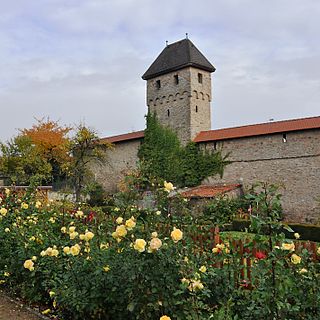
Kirchheimbolanden, the capital of Donnersbergkreis, is a town in Rhineland-Palatinate, south-western Germany. It is situated approximately 25 km west of Worms, and 30 km north-east of Kaiserslautern. The first part of the name, Kirchheim, dates back to 774. It became a town in 1368, and the Sponheim family improved its security with many towers and walls. William, Duke of Nassau, ancestor of the royal families of Belgium, Sweden, Denmark and Norway, and of the grand-ducal family of Luxembourg, was born in Kirchheimbolanden. It was also ruled by the First French Empire between 1792 and 1814, before passing to the Kingdom of Bavaria in 1815. It was a rural district centre in the Rheinkreis, which was renamed Pfalz (Palatinate) in 1835.

Mont-Tonnerre[mɔ̃.tɔ.nɛʁ] was a department of the First French Republic and later the First French Empire in present-day Germany. It was named after the highest point in the Palatinate, the Donnersberg. It was the southernmost of four departments formed in 1797 when the west bank of the Rhine was annexed by France. Prior to the French occupation, its territory was divided between the Archbishopric of Mainz, the Bishopric of Speyer, the Bishopric of Worms, Nassau-Weilburg, Hesse-Darmstadt, the Electorate of the Palatinate and the imperial cities of Worms and Speyer. Its territory is now part of the German states of Rhineland-Palatinate and Saarland. Its capital was Mainz.
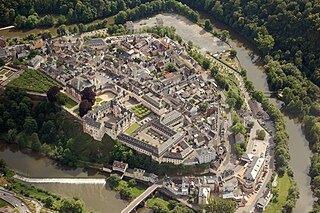
Weilburg is, with just under 13,000 inhabitants, the third biggest town in Limburg-Weilburg district in Hesse, Germany, after Limburg an der Lahn and Bad Camberg.

The Duchy of Nassau was an independent state between 1806 and 1866, located in what is now the German states of Rhineland-Palatinate and Hesse. It was a member of the Confederation of the Rhine and later of the German Confederation. Its ruling dynasty, now extinct, was the House of Nassau. The duchy was named for its historical core city, Nassau, although Wiesbaden rather than Nassau was its capital. In 1865, the Duchy of Nassau had 465,636 inhabitants. After being occupied and annexed into the Kingdom of Prussia in 1866 following the Austro-Prussian War, it was incorporated into the Province of Hesse-Nassau. The area today is a geographical and historical region, Nassau, and Nassau is also the name of the Nassau Nature Park within the borders of the former duchy.
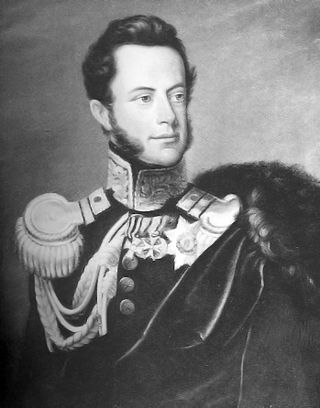
Wilhelm was joint sovereign Duke of Nassau, along with his father's cousin Frederick Augustus, reigning from 1816 until 1839. He was also sovereign Prince of Nassau-Weilburg from 1816 until its incorporation into the duchy of Nassau.

The County of Saarbrücken was an Imperial State in the Upper Lorraine region, with its capital at Saarbrücken. From 1381 it belonged to the Walram branch of the Rhenish House of Nassau.

Laurenburg is a municipality in the Rhein-Lahn district of Rhineland-Palatinate, in western Germany. The town, a health resort situated in the lower Lahn River valley, belongs to the Diez Municipal Association.

Karlsberg Castle is a castle ruin on Buchenberg east of Homburg in Saarland, Germany. The castle was constructed from 1778 to 1788 in Baroque and Classical style by Johann Christian von Mannlich, architect and general building director of the dukes of Zweibrücken, by order of Charles II August, Duke of Zweibrücken. The castle was the largest country palace of Europe and served as the residence of the Duke of Zweibrücken. In 1793 the castle was destroyed by French revolutionary troops.
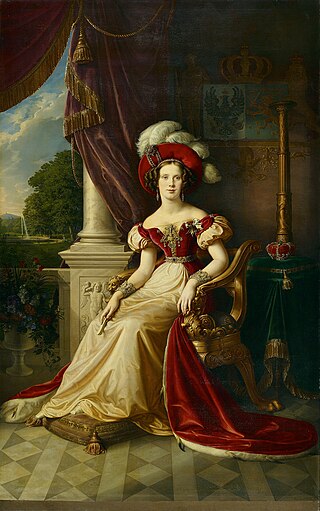
Princess Marianne of the Netherlands, Princess of Orange-Nassau was the youngest child of King William I of the Netherlands and Princess Wilhelmine of Prussia.

Rastede Palace is a country estate at Rastede near Oldenburg, Germany. The town of Rastede is about 12km north of Oldenburg.

Johann Ernst of Nassau-Weilburg was an Imperial Generalfeldmarschall, from 1675 to 1688 Count and from 1688 until his death Prince (Fürst) of Nassau-Weiburg.

Biebrich Palace is a Baroque residence (Schloss) in the borough of Biebrich in the city of Wiesbaden, Hesse, Germany. Built in 1702 by Prince Georg August Samuel of Nassau-Idstein, it served as the ducal residence for the independent Duchy of Nassau from 1816 until 1866.

Heinrich XIII, Prince Reuss of Greiz was Prince Reuss of Greiz from 1800 to 1817.

Friedrich August, Duke of Nassau, Prince of Nassau-Usingen was the last Prince of Nassau-Usingen and, jointly with his cousin, Friedrich Wilhelm of Nassau-Weilburg, first Duke of Nassau. He died without surviving male issue and was succeeded by his cousin's son, Wilhelm.
Philip III, Count of Nassau-Weilburg was a Count of the Nassau-Weilburg. Among his major achievements were the introduction of the Reformation, the foundation of the Gymnasium Philippinum in Weilburg and the start of the construction of Schloss Weilburg.

Wiesbaden City Palace is a neo-classical building in the center of Wiesbaden, Germany. It was completed in 1841 as the principal city residence of the Dukes of Nassau. The palace has several wings, 145 rooms, and is architecturally integrated with a group of ancillary buildings constructed both before and after it was built. With ornate towers, gables and a slate roof laid in herringbone patterns, the three-story complex lends charm and its name to the central square of Wiesbaden: Palace Square.
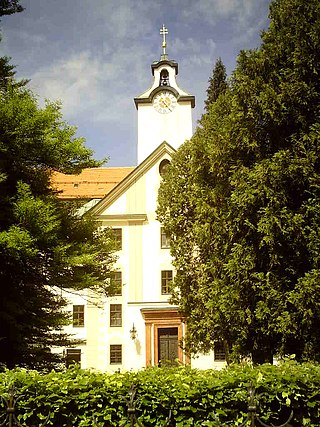
Schloss Hohenburg is a Baroque schloss (palace) in Lenggries, Bavaria, Germany.

Schloss Weilburg is a Baroque schloss in Weilburg, Hesse, Germany. It is located on a spur above the river Lahn and occupies about half of the area of the Old Town of Weilburg. It contains the Hochschloss, built between 1530 and 1572, which is one of the best-preserved Renaissance palaces in Hesse. In the 1700s, the palace was expanded by John Ernst, Count of Nassau-Weilburg, and his builder, Julius Ludwig Rothweil. The buildings and gardens now belong to the Verwaltung der Staatlichen Schlösser und Gärten Hessen, and they can be visited as a museum on guided tours. Parts of the palace are venues for the music festival Weilburger Schlosskonzerte, which is named after the palace.